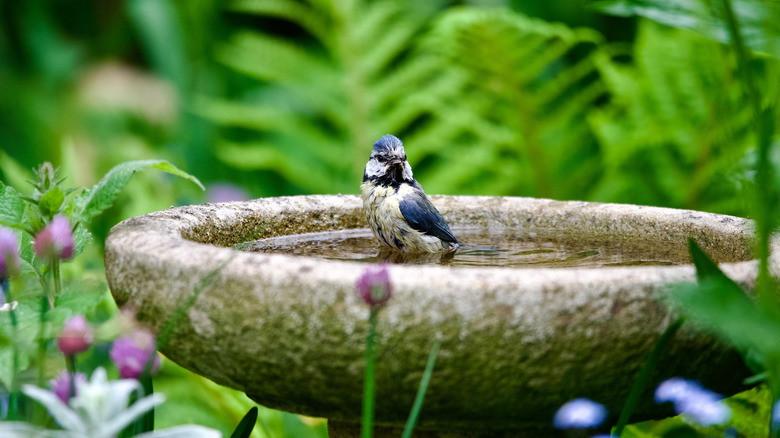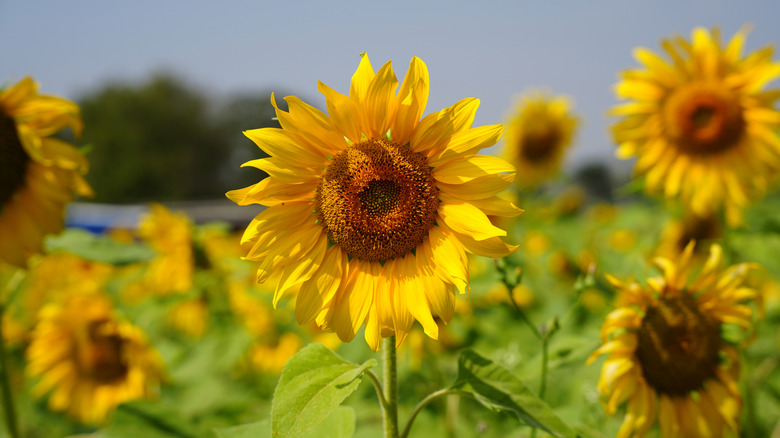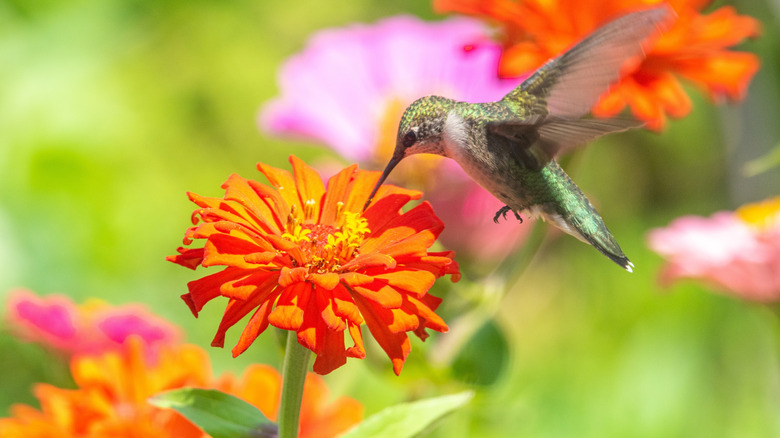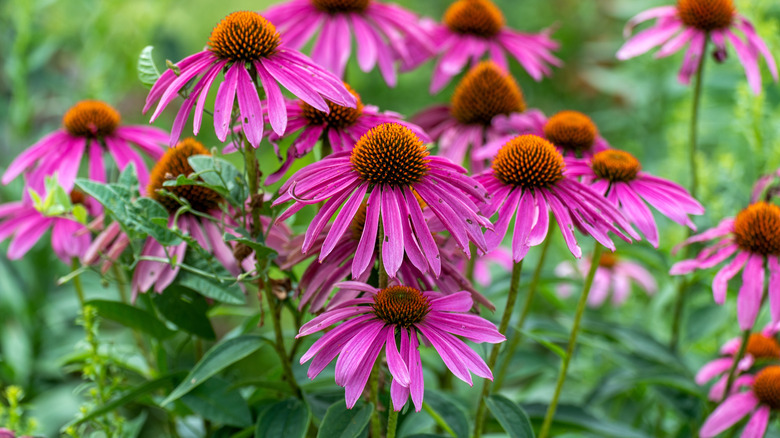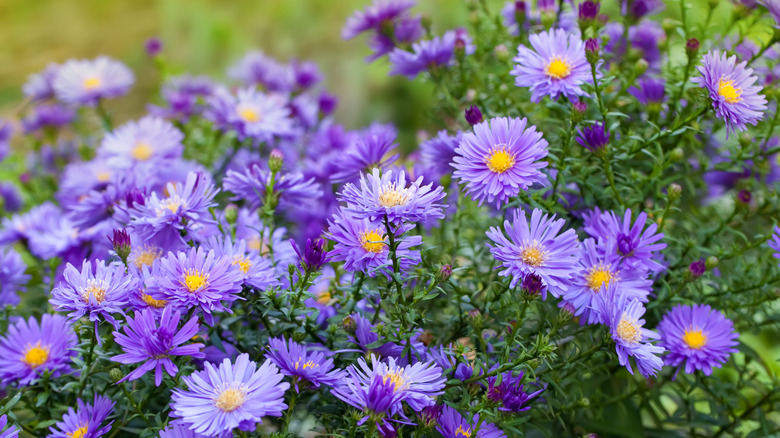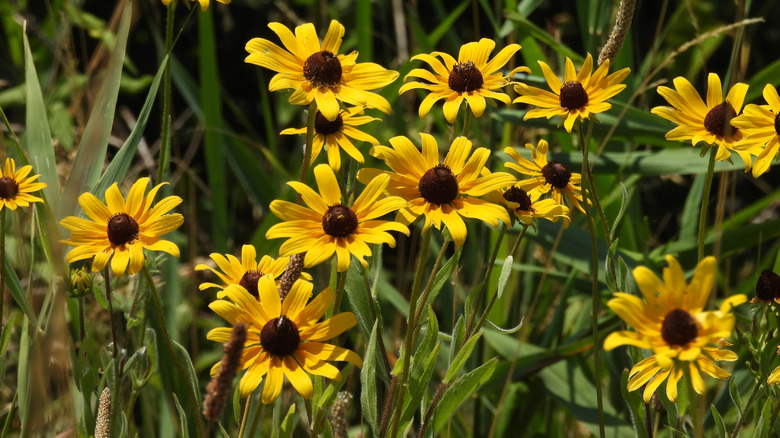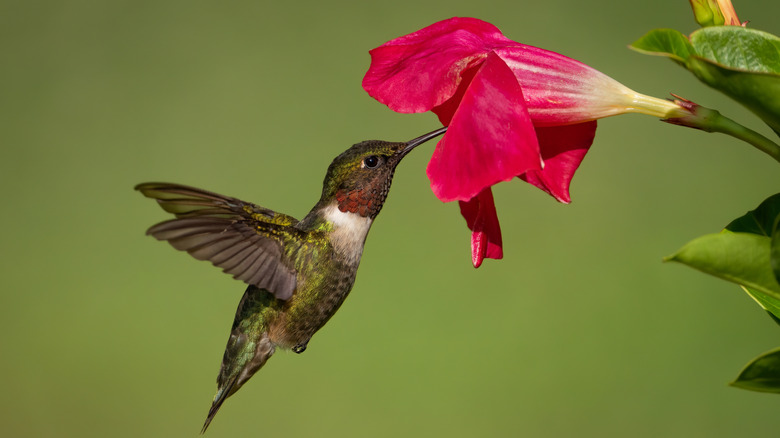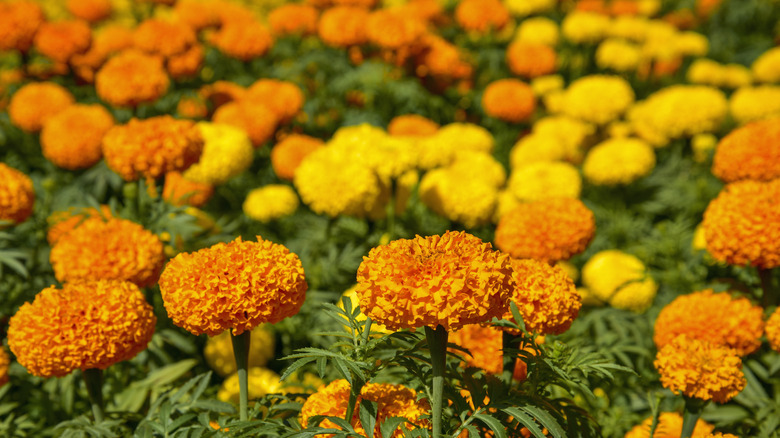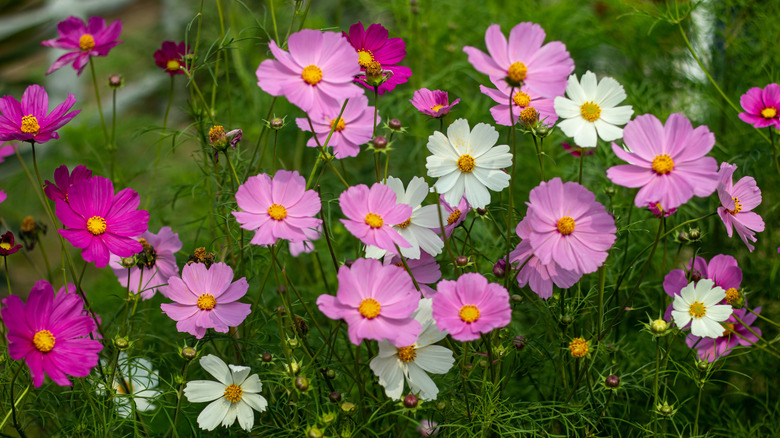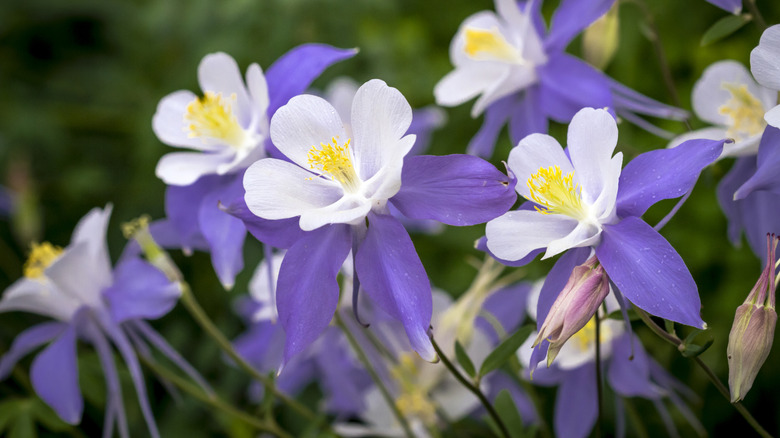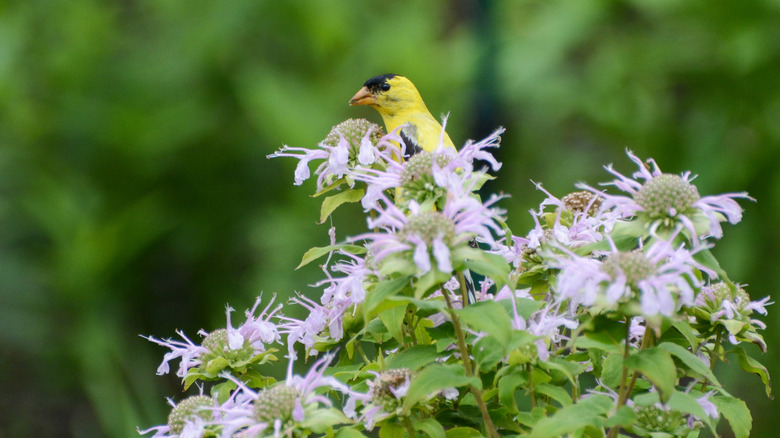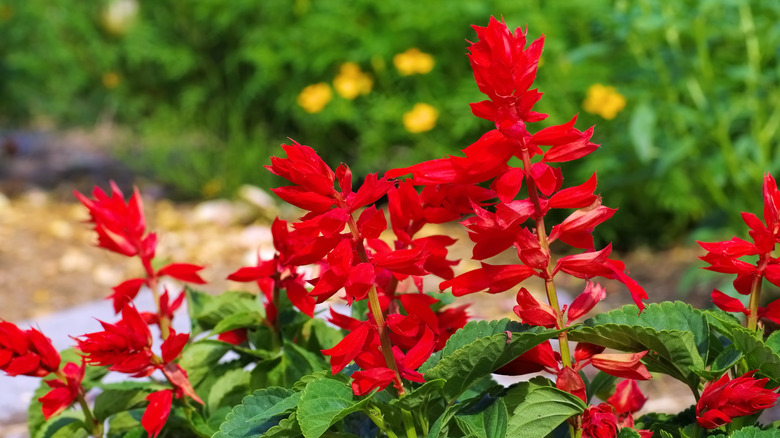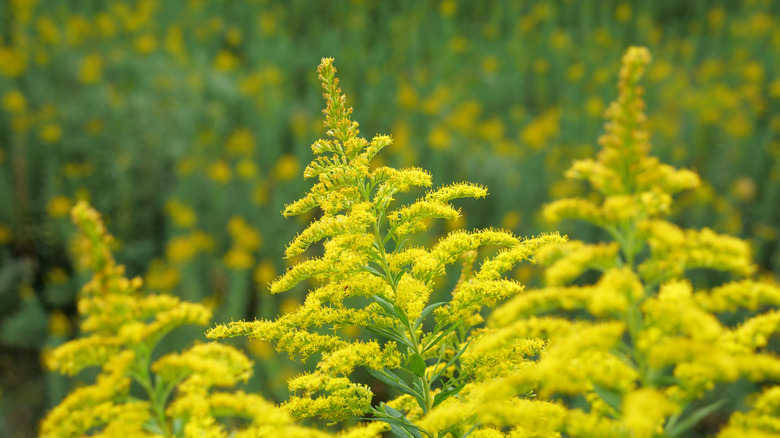Plant These 12 Flowers Near Your Birdbath To Turn It Into A Bird Magnet
Birdbaths can imbue your garden with a sense of whimsy and magic. Not only do they provide our feathered friends with a spot to drink, bathe, and make merry, they are a cool way to get to know some of the wildlife your backyard teems with and engage in low-stakes bird-watching. There are plenty of simple tips and tricks to attract more birds to your birdbath, including placing it in a shady location and keeping the water fresh and clean. If you find that your bath still isn't a popular hang-out, despite the adjustments, another way of making sure your bath gets plenty of visitors throughout the year is to plant flowers around it. Vibrant colors like red, orange, and blue catch the attention of particular bird species, while the promise of food and protection ensures they keep coming back for more.
Planting flowers around your birdbath to invite beautiful wildlife to your garden will definitely enhance the yard's beauty, but they will also supply an enticing buffet of seeds and other food for neighborhood birds. Once you have decided to add flowers to your birdbath to keep the birds happy, you need to be strategic about the specific species to plant. Just because a flower has an eye-catching bloom, doesn't mean songbirds and other species will automatically flock to it. For example, birds steer clear of white flowers. Be sure to include native flowers that will support local wildlife. Consider including plants and shrubs that grow low to the ground to tempt visiting birds to use them for nesting or a safe rest between flights. And avoid using insecticides, which can harm insects and the birds that eat them.
Sunflowers around a birdbath have seeds birds love
Sunflowers (Helianthus spp.) are coveted annuals that grow fast and tall; many garden varieties reach 4 to 5 feet high. The blooms are often yellow, though they also come in maroon, cream, pink, and other colors. Hardy in Zones 2 through 11, plant sunflowers in full sun to maximize their beauty. Once the blooms are spent, the pistils transform into nutrient-rich food with a high fat content. In fact, black-oil sunflower seeds are the No. 1 choice for many birds — for example, Northern cardinals, chickadees, finches, and jays.
Attract hummingbirds to a birdbath with zinnias
An essential flower if you want to attract pollinators, zinnias (Zinnia spp.) need at least six hours of sun every day in order to thrive. Zinnia blooms provide pollen and nectar, a feast for insects like bees and moths. Their presence will then entice birds to visit, since insects are another source of food. In addition, the plant's seeds are sought out by American goldfinches, mourning doves, and sparrows, among other birds. If you're lucky, you might see goldfinches sitting on the stems enjoying a meal. These annuals grow in Zones 3 through 10.
Bright coneflowers bring goldfinches to your birdbath
Though at first glance the head of coneflowers (Echinacea spp.) may look like a single flower, it's actually composed of many individual blooms. Easy to grow and drought tolerant, coneflowers have a tendency to overtake gardens if you don't stay on top of weeding out seedlings. Growing to 3 or 4 feet tall and hardy in Zones 3 to 9, the fall seeds of this native perennial are a tasty snack for goldfinches, in particular.
Plant a birdbath with asters to feed seed-loving avians
These daisy-like flowers are a popular addition to any garden. Generally hardy in Zones 3 to 9, asters (Symphyotrichum spp.) are named after the Greek word for star, and usually bloom into late fall and even early winter, extending the colors of your garden after most other flowers have gone to seed. They are a keystone species that provides food for a wide range of mammals and birds. Frequent nibblers include nuthatches, towhees, goldfinches, orange-crowned warblers, and dark-eyed juncos.
Seed-eating birds love a birdbath surrounded by black-eyed Susans
Hardy in Zones 3 to 11, black-eyed Susans (Rudbeckia hirta) are native across the eastern U.S. Defined by yellow petals that surround a dark brown center, this perennial prefers moist, loamy soils and can tolerate drought. Its stems reach 1 to 3 feet tall, depending on environmental conditions, and the plant does best in full sun. If you plant these beauties, you'll attract birds like chickadees, American goldfinches, and house finches, who will feast on the seed of flowers that have not been deadheaded after growing season.
Pretty petunias are perfect around a birdbath for hummingbirds
Petunias (Petunia spp.) can be grown as annuals or short-lived perennials. Hardy in Zones 9 through 11, they prefer full sun and moist soil, similar to sunflowers and black-eyed Susans. There are a plethora of varieties to choose from with petals in colors ranging from purple and red to pink and yellow. Due to their tubular shape, petunia flowers are a favorite of hummingbirds. Petunias also have a long bloom season, which means plenty of opportunities to feed your feathered friends.
Invite insectivorous birds to a birdbath with marigolds
One flower that won't attract hummingbirds due to the shape of their petals are marigolds (Tagetes spp.). Hardy in Zones 2 through 11, these ornamental annuals are a great fit for beginners, since they are a cinch to grow and maintain. While they can repel pests like deer and rabbit, who are no fans of their scent, they are a pollinating insect magnet, which are a good source of food for insectivorous birds — in fact, crows and blackbirds will rip the blooms to shreds while looking for insects to munch on.
Put cosmos around a birdbath to bring in sparrows and doves
Native to Mexico, cosmos (Cosmos bipinnatus) flower between June and October. Like a few of the other flowering plans on this list, cosmos are a great choice for beginner gardeners because they are easy to grow and can adapt to most soil types of soil. They're hardy in Zones 2 to 11. Although cosmos are a popular choice for cut flowers, consider allowing your blooms to go to seed if you want to attract white-throated sparrows and mourning doves to your garden.
Columbines near a birdbath are a sometimes-snack for hummers
Featuring spurred petals that look like eagle talons, columbines (Aquilegia spp.) are a short-lived perennials that do well in growing conditions on the shadier and cooler side. Hardy in Zones 3 to 9, these elegant flowers usually bloom in the spring, meaning they are a great option for those who want a burst of color right before summer. Due to their bell shape, columbine blooms are a sometimes-snack for hummingbirds. The birds are attracted to their candy-like nectar, especially if the flowers are red or pink in hue.
A bee balm-planted birdbath feeds insect-eating birds
Lure hummingbirds into your garden with this native perennial. Bee balm (Monarda spp.) attracts pollinating insects and birds alike. Hardy in Zones 3 through 9, bee balm's preferred requirements are moist soil and full sun if you want luscious blooms and lots of growth. Though it might be tempting to cut the stems back after the first frost, there's no harm in allowing the spent blooms to go to seed. During the winter months, these seed heads will provide much needed nutrients to goldfinches and sparrows.
Hummingbirds will flock to red salvia flowers by a birdbath
If you're searching for the perfect flower to fill in space near your birdbath, look no further than salvias (Salvia spp.). There are over 1,000 introduced and native species in this genus, with some being annuals and others perennials. The tubular flowers are full of sweet nectar — plant bright red salvia (such as Salvia splendens or scarlet sage) if you want to attract rufous, Allen's, and Anna's hummingbirds. In addition, house finches, goldfinches, and other birds are fans of their seeds. Most salvias thrive in Zones 5 to 10.
Songbirds will visit birdbaths planted with goldenrod
Goldenrods (Solidago spp.) are a powerhouse addition to the garden around your birdbath. Native to North America and hardy in Zones 2 through 8, this stunning perennial can grow over 6 feet tall, depending on the variety. Blooming from mid summer to fall, butterflies and other pollinating insects love to nibble on the pollen and nectar, which brings a bevy of insectivorous birds like tree swallows and black phoebes. Goldenrod seeds are also a popular choice among songbirds, including black-capped chickadees, Carolina wrens, indigo buntings, pine siskins, and many more.
